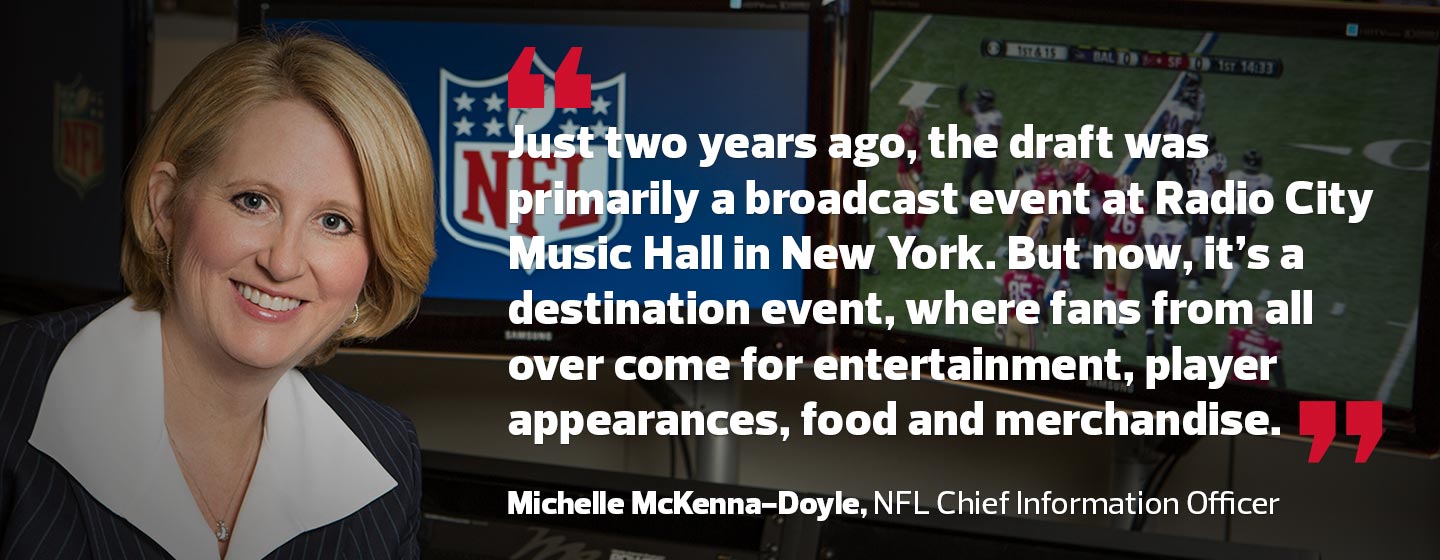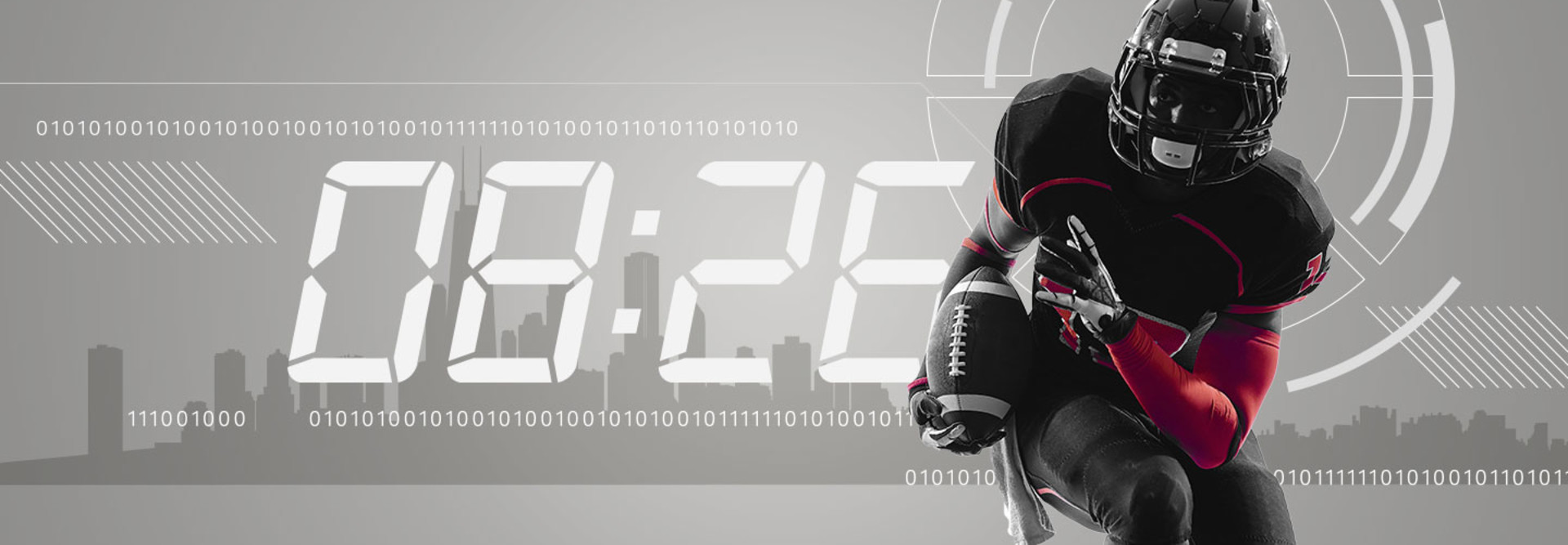How NFL IT Makes the Magic of the Draft Come to Life
As NFL Commissioner Roger Goodell walks to the podium and prepares to kick off the NFL draft on prime-time television, the league’s 32 teams won’t be the only ones on the clock. NFL CIO Michelle McKenna-Doyle and her IT team are on hand and at the ready to make sure the three-day extravaganza goes smoothly — with zero seconds of downtime.
After 50 years in New York City, the NFL is holding the draft in Chicago for the second straight year. Doing so requires the NFL’s technology staff to ship IT infrastructure to the Windy City and build a mini data center on-site. The equipment includes servers, networking gear, an IP phone system and an IP-based video conferencing system.
“There’s a lot of technical components to the draft, so we have to be able to take those on the road,” she says.
The draft, which attracts more than seven million TV viewers, is critical for NFL teams because it allows them to improve their rosters with young players from college. But with the move to Chicago, the NFL has also created an accompanying three-day, outdoor fan festival — free to the public — called “Draft Town,” which draws more than 200,000 fans to Grant Park.
McKenna-Doyle is not only in charge of the technology for the football operations part of the draft, but also the Wi-Fi and the point-of-sale systems at the 900,000 square-foot festival.
“Just two years ago, the draft was primarily a broadcast event at Radio City Music Hall in New York. But now, it’s a destination event, where fans from all over come for entertainment, player appearances, food and merchandise,” she says. “It’s really become a major, multiday event similar to the Super Bowl. And in that respect, we bring an entire Wi-Fi system that we put in both the theater and the common areas.”
NFL’s Cloud-Based Draft Application
While most mock drafts have the Los Angeles Rams and Philadelphia Eagles picking Cal-Berkeley quarterback Jared Goff and North Dakota State quarterback Carson Wentz with the first two picks, respectively, McKenna-Doyle ran a mock draft of her own on Tuesday to test the IT equipment at Grant Park and the nearby Auditorium Theatre, where the first three rounds of the draft are announced.
“We do a full run, and make sure all the systems are working and everything is connected,” she says.
The NFL relies on a centralized draft application and database, housed in a private cloud in its New York data center, that teams and league officials use to conduct the draft. It gives them an updated list of the eligible college players still available and an official time clock for the amount of time a team has remaining to make a selection, McKenna-Doyle says.
Prior to the draft, the NFL’s IT department installed several servers and a local area network (LAN) on-site in Chicago, and through a dedicated Internet connection, the servers communicate with the private cloud and allow team representatives and league officials to access the application and database, she says.

Photo: NFL
During the draft, each of the 32 teams has a table at Selection Square, a gigantic outdoor tent at Grant Park that serves as the central hub of the draft. Each table is equipped with a Microsoft Surface Pro 4, which allows team representatives to access the draft application and database, and an IP phone, which allows them to discuss potential selections or trades with club officials back at headquarters, she says.
“They communicate and get the pick over the phone,” she says.
Once notified of the pick, the on-site team representative writes the player’s name, position and school on a card and submits it to an NFL staff member. That staff member then radios the selection to an NFL player personnel representative, who in turn, types the player’s name into the database to notify every team of the pick. An NFL official then checks the name for accuracy, and if it’s a first round pick, relays the name to the commissioner, who announces the pick on stage at Auditorium Theatre.
Drafted players also have access to a high-end IP video conferencing system, so that they can have a quick, private chat with their new team’s coaches and management. And if a team is holding a draft watch party at their stadium, the franchise can use the video conferencing system to introduce players to their fans, she says.
To ensure uptime and reliability, the NFL has built-in redundancy throughout the draft’s IT infrastructure in Chicago. For example, the tech staff has deployed redundant servers to ensure access to the draft application and database, as well as redundant switches for the phone system and Wi-Fi access points, McKenna-Doyle says. They also have a manual clock just in case the application with the official clock goes down.
“We have to be ready for just-in-case scenarios,” she explains.
And to ensure a positive fan experience, the NFL has installed several hundred wireless access points; the league has also partnered with several wireless carriers to make sure there is optimal cell coverage throughout the event, she says.
NFL IT Is Ready to Troubleshoot
During the draft, McKenna-Doyle and her team of 12 to 15 IT staffers — which includes network engineers, software engineers and IT security experts — will monitor the IT infrastructure in a command center in front of the stage at Selection Square, where the picks for the final four rounds will be announced. She likens the IT staff’s location to an orchestra pit in a theater.
“We’re set up in front of the stage like a Broadway show,” she says.
But instead of conducting music, McKenna-Doyle is supervising the entire IT operation. She and her team are ready to jump in and troubleshoot if needed.
“My job ends up being in the middle of it all, staying on the radio and making sure all the systems are running properly,” she says.
McKenna-Doyle did not implement any new technology this year, but she did bolster the number of access points to ensure good Wi-Fi connections. She’s also increasing security measures to prevent hacks and information leaks.
“Anytime we have that many people in one place, we have to be ever vigilant,” she says. “We have new security practices for IT that we are putting in place, but otherwise, it’s business as usual.”
Overall, McKenna-Doyle says the NFL draft is one of her favorite events of the year because it marks the beginning of the league’s season.
“The Super Bowl is the culmination of everything. That is exciting. But with the draft, you watch these young men’s lives change so drastically and watch their families be so proud,” she says. “To see the drama unfold, who will get picked and when, the fact that it’s on the clock, and trades start to happen, it’s a good adrenaline rush to watch it happen and sit in the middle of it.”









